ECON3003 - Analyzing Japan's Trade Behaviour and Financial Crises
VerifiedAdded on 2023/06/12
|7
|1201
|430
Essay
AI Summary
This essay provides an analysis of Japan's economy from 1991 to 2016, focusing on its GDP performance, export and import trends, and exchange rate fluctuations. The analysis highlights the impact of events such as the global financial crisis on Japan's trade flows. It also discusses Japan's trade policies, including export promotion strategies and import regulations, as well as the composition of its trade with key partners like the United States, China, and South Korea. The essay also explores how the global financial crisis significantly impacted Japan's trade due to its reliance on income-elastic industrial supplies and intermediate goods, and how policymakers have since promoted the export of finished goods to mitigate future shocks. The data used in this analysis has been retrieved from the World Bank data.

Course
Name
Institution Affiliation
Name
Institution Affiliation
Paraphrase This Document
Need a fresh take? Get an instant paraphrase of this document with our AI Paraphraser
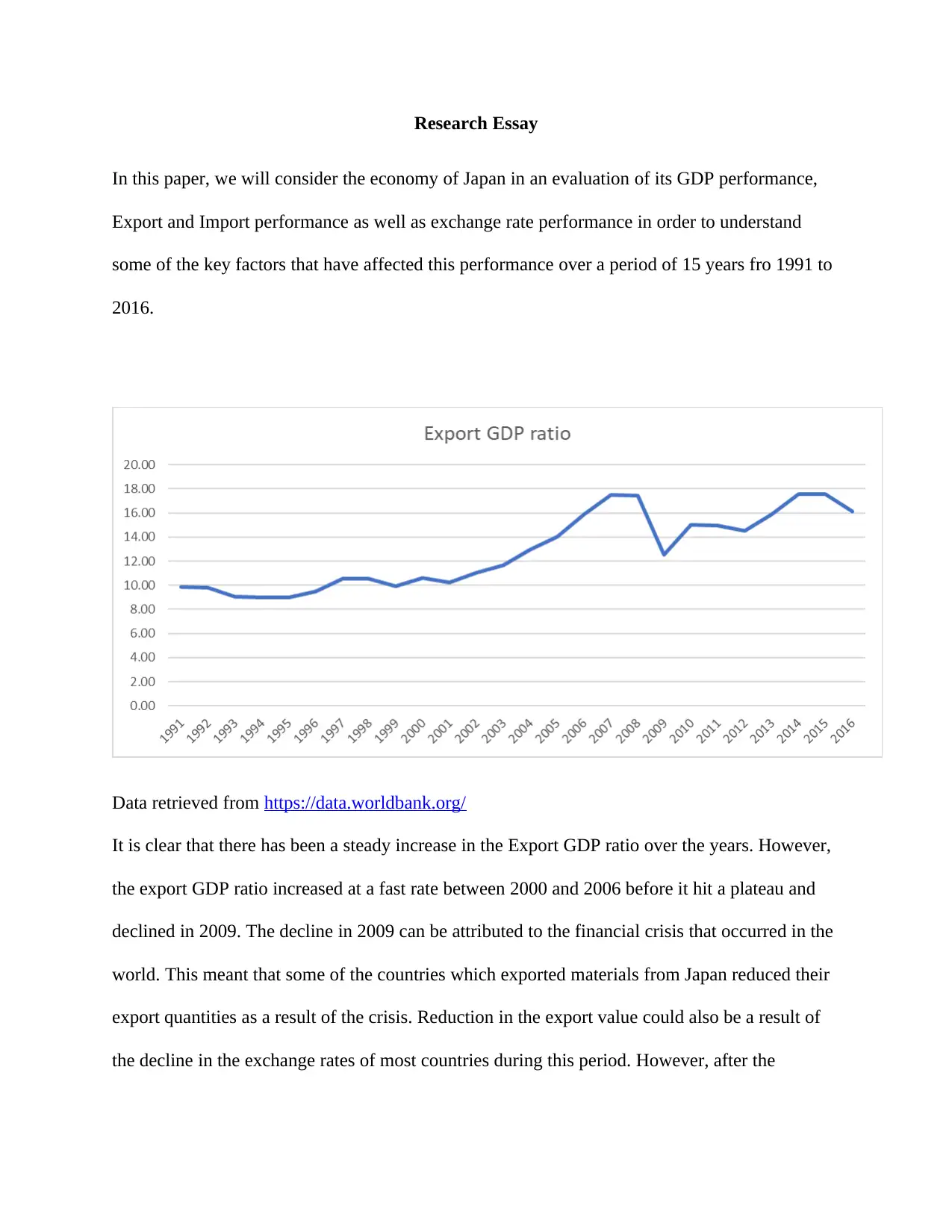
Research Essay
In this paper, we will consider the economy of Japan in an evaluation of its GDP performance,
Export and Import performance as well as exchange rate performance in order to understand
some of the key factors that have affected this performance over a period of 15 years fro 1991 to
2016.
Data retrieved from https://data.worldbank.org/
It is clear that there has been a steady increase in the Export GDP ratio over the years. However,
the export GDP ratio increased at a fast rate between 2000 and 2006 before it hit a plateau and
declined in 2009. The decline in 2009 can be attributed to the financial crisis that occurred in the
world. This meant that some of the countries which exported materials from Japan reduced their
export quantities as a result of the crisis. Reduction in the export value could also be a result of
the decline in the exchange rates of most countries during this period. However, after the
In this paper, we will consider the economy of Japan in an evaluation of its GDP performance,
Export and Import performance as well as exchange rate performance in order to understand
some of the key factors that have affected this performance over a period of 15 years fro 1991 to
2016.
Data retrieved from https://data.worldbank.org/
It is clear that there has been a steady increase in the Export GDP ratio over the years. However,
the export GDP ratio increased at a fast rate between 2000 and 2006 before it hit a plateau and
declined in 2009. The decline in 2009 can be attributed to the financial crisis that occurred in the
world. This meant that some of the countries which exported materials from Japan reduced their
export quantities as a result of the crisis. Reduction in the export value could also be a result of
the decline in the exchange rates of most countries during this period. However, after the
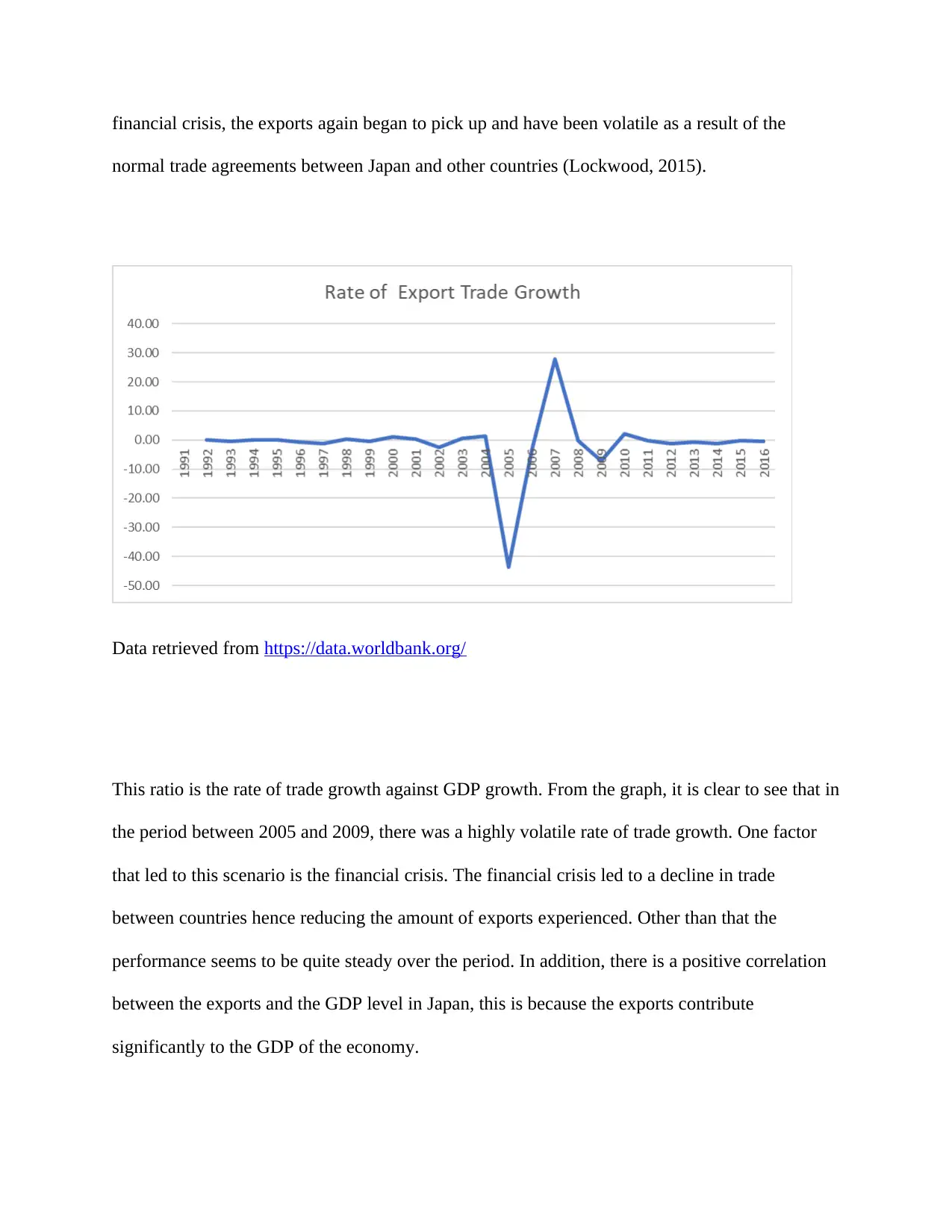
financial crisis, the exports again began to pick up and have been volatile as a result of the
normal trade agreements between Japan and other countries (Lockwood, 2015).
Data retrieved from https://data.worldbank.org/
This ratio is the rate of trade growth against GDP growth. From the graph, it is clear to see that in
the period between 2005 and 2009, there was a highly volatile rate of trade growth. One factor
that led to this scenario is the financial crisis. The financial crisis led to a decline in trade
between countries hence reducing the amount of exports experienced. Other than that the
performance seems to be quite steady over the period. In addition, there is a positive correlation
between the exports and the GDP level in Japan, this is because the exports contribute
significantly to the GDP of the economy.
normal trade agreements between Japan and other countries (Lockwood, 2015).
Data retrieved from https://data.worldbank.org/
This ratio is the rate of trade growth against GDP growth. From the graph, it is clear to see that in
the period between 2005 and 2009, there was a highly volatile rate of trade growth. One factor
that led to this scenario is the financial crisis. The financial crisis led to a decline in trade
between countries hence reducing the amount of exports experienced. Other than that the
performance seems to be quite steady over the period. In addition, there is a positive correlation
between the exports and the GDP level in Japan, this is because the exports contribute
significantly to the GDP of the economy.
⊘ This is a preview!⊘
Do you want full access?
Subscribe today to unlock all pages.

Trusted by 1+ million students worldwide
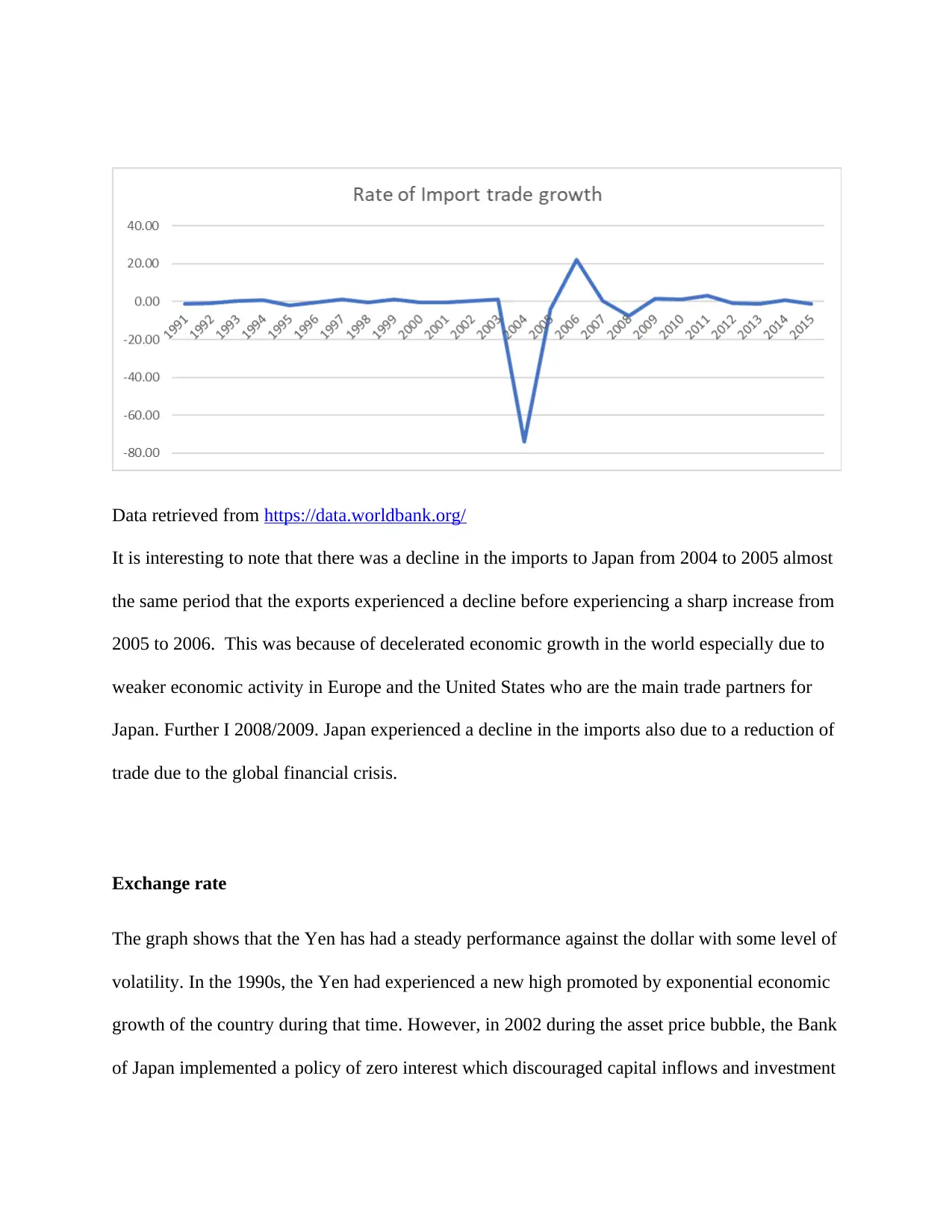
Data retrieved from https://data.worldbank.org/
It is interesting to note that there was a decline in the imports to Japan from 2004 to 2005 almost
the same period that the exports experienced a decline before experiencing a sharp increase from
2005 to 2006. This was because of decelerated economic growth in the world especially due to
weaker economic activity in Europe and the United States who are the main trade partners for
Japan. Further I 2008/2009. Japan experienced a decline in the imports also due to a reduction of
trade due to the global financial crisis.
Exchange rate
The graph shows that the Yen has had a steady performance against the dollar with some level of
volatility. In the 1990s, the Yen had experienced a new high promoted by exponential economic
growth of the country during that time. However, in 2002 during the asset price bubble, the Bank
of Japan implemented a policy of zero interest which discouraged capital inflows and investment
It is interesting to note that there was a decline in the imports to Japan from 2004 to 2005 almost
the same period that the exports experienced a decline before experiencing a sharp increase from
2005 to 2006. This was because of decelerated economic growth in the world especially due to
weaker economic activity in Europe and the United States who are the main trade partners for
Japan. Further I 2008/2009. Japan experienced a decline in the imports also due to a reduction of
trade due to the global financial crisis.
Exchange rate
The graph shows that the Yen has had a steady performance against the dollar with some level of
volatility. In the 1990s, the Yen had experienced a new high promoted by exponential economic
growth of the country during that time. However, in 2002 during the asset price bubble, the Bank
of Japan implemented a policy of zero interest which discouraged capital inflows and investment
Paraphrase This Document
Need a fresh take? Get an instant paraphrase of this document with our AI Paraphraser
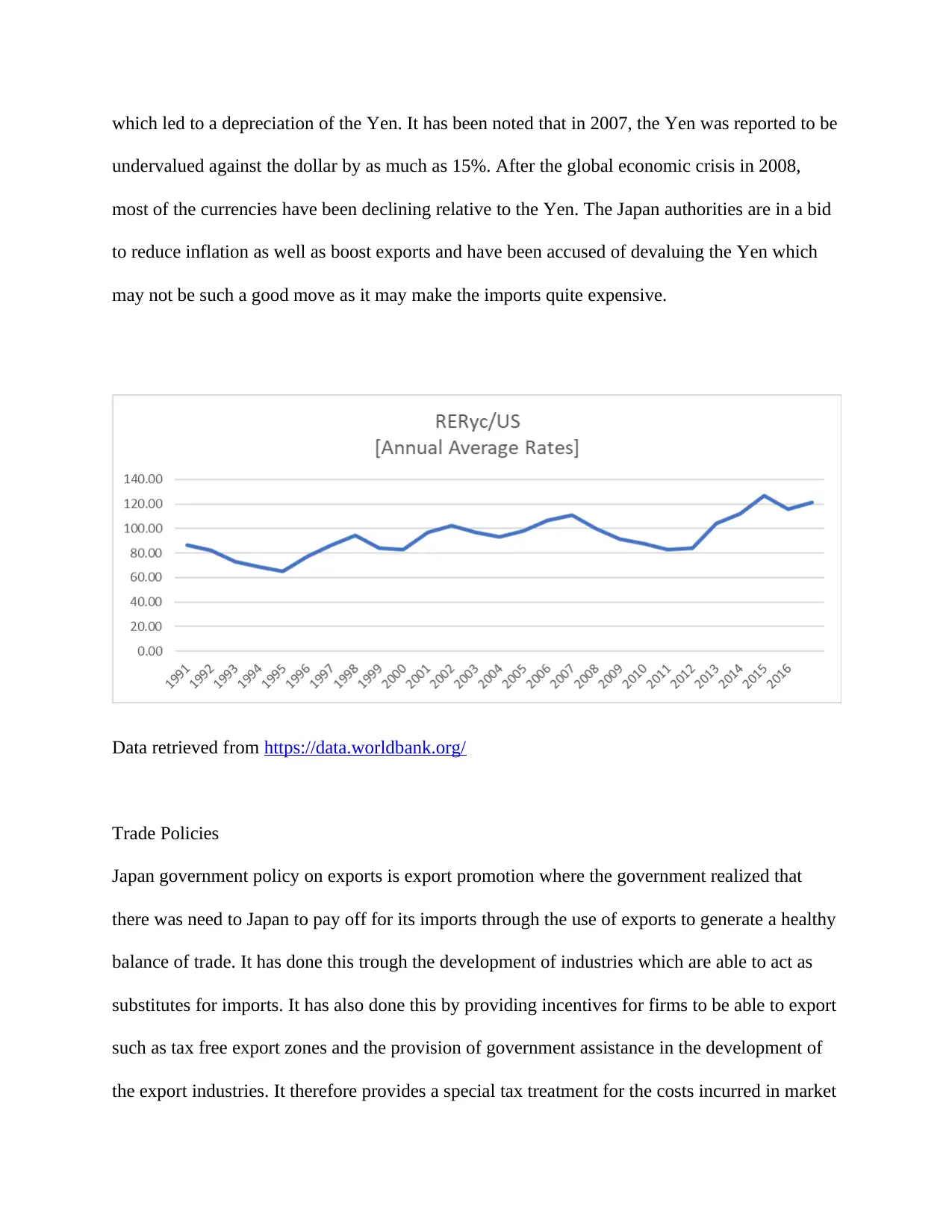
which led to a depreciation of the Yen. It has been noted that in 2007, the Yen was reported to be
undervalued against the dollar by as much as 15%. After the global economic crisis in 2008,
most of the currencies have been declining relative to the Yen. The Japan authorities are in a bid
to reduce inflation as well as boost exports and have been accused of devaluing the Yen which
may not be such a good move as it may make the imports quite expensive.
Data retrieved from https://data.worldbank.org/
Trade Policies
Japan government policy on exports is export promotion where the government realized that
there was need to Japan to pay off for its imports through the use of exports to generate a healthy
balance of trade. It has done this trough the development of industries which are able to act as
substitutes for imports. It has also done this by providing incentives for firms to be able to export
such as tax free export zones and the provision of government assistance in the development of
the export industries. It therefore provides a special tax treatment for the costs incurred in market
undervalued against the dollar by as much as 15%. After the global economic crisis in 2008,
most of the currencies have been declining relative to the Yen. The Japan authorities are in a bid
to reduce inflation as well as boost exports and have been accused of devaluing the Yen which
may not be such a good move as it may make the imports quite expensive.
Data retrieved from https://data.worldbank.org/
Trade Policies
Japan government policy on exports is export promotion where the government realized that
there was need to Japan to pay off for its imports through the use of exports to generate a healthy
balance of trade. It has done this trough the development of industries which are able to act as
substitutes for imports. It has also done this by providing incentives for firms to be able to export
such as tax free export zones and the provision of government assistance in the development of
the export industries. It therefore provides a special tax treatment for the costs incurred in market
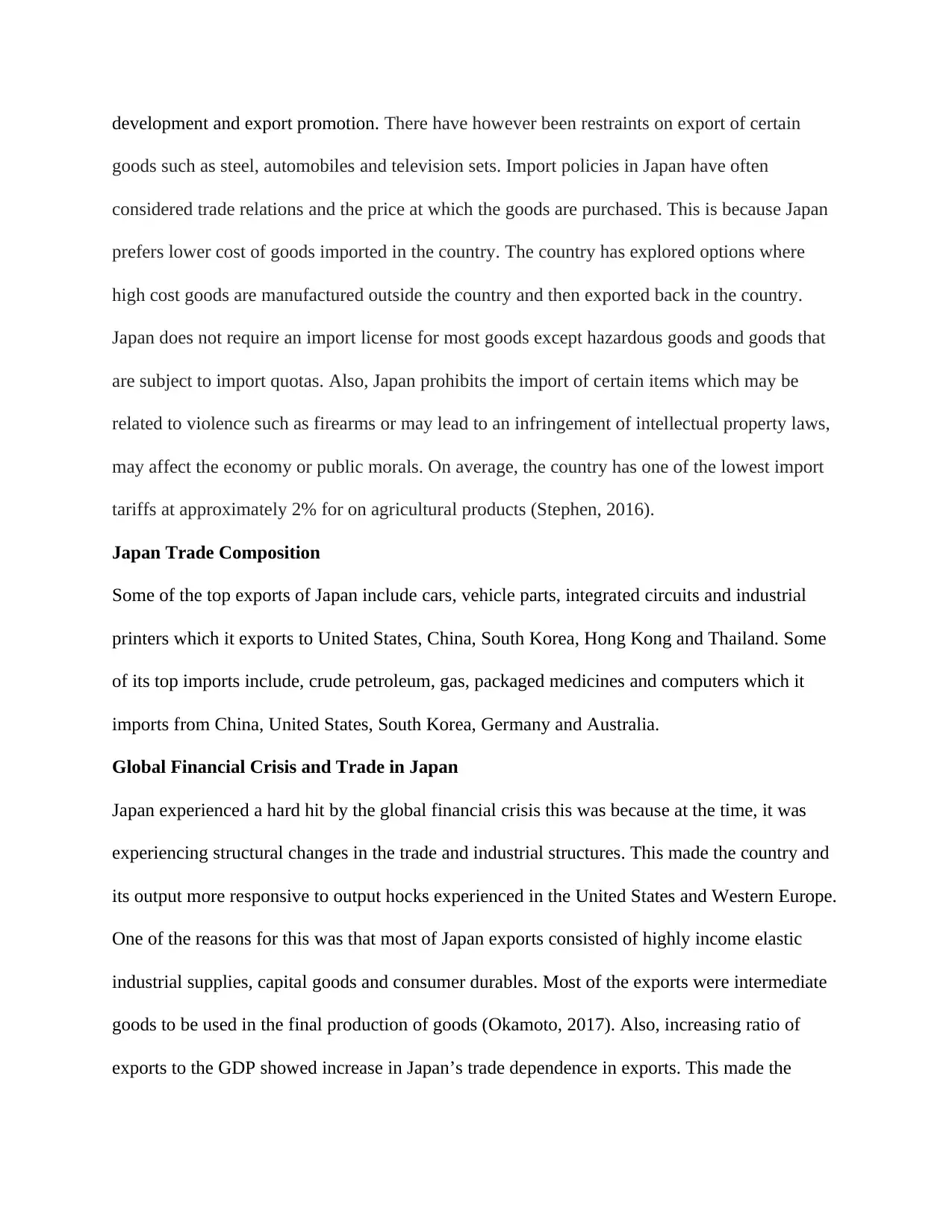
development and export promotion. There have however been restraints on export of certain
goods such as steel, automobiles and television sets. Import policies in Japan have often
considered trade relations and the price at which the goods are purchased. This is because Japan
prefers lower cost of goods imported in the country. The country has explored options where
high cost goods are manufactured outside the country and then exported back in the country.
Japan does not require an import license for most goods except hazardous goods and goods that
are subject to import quotas. Also, Japan prohibits the import of certain items which may be
related to violence such as firearms or may lead to an infringement of intellectual property laws,
may affect the economy or public morals. On average, the country has one of the lowest import
tariffs at approximately 2% for on agricultural products (Stephen, 2016).
Japan Trade Composition
Some of the top exports of Japan include cars, vehicle parts, integrated circuits and industrial
printers which it exports to United States, China, South Korea, Hong Kong and Thailand. Some
of its top imports include, crude petroleum, gas, packaged medicines and computers which it
imports from China, United States, South Korea, Germany and Australia.
Global Financial Crisis and Trade in Japan
Japan experienced a hard hit by the global financial crisis this was because at the time, it was
experiencing structural changes in the trade and industrial structures. This made the country and
its output more responsive to output hocks experienced in the United States and Western Europe.
One of the reasons for this was that most of Japan exports consisted of highly income elastic
industrial supplies, capital goods and consumer durables. Most of the exports were intermediate
goods to be used in the final production of goods (Okamoto, 2017). Also, increasing ratio of
exports to the GDP showed increase in Japan’s trade dependence in exports. This made the
goods such as steel, automobiles and television sets. Import policies in Japan have often
considered trade relations and the price at which the goods are purchased. This is because Japan
prefers lower cost of goods imported in the country. The country has explored options where
high cost goods are manufactured outside the country and then exported back in the country.
Japan does not require an import license for most goods except hazardous goods and goods that
are subject to import quotas. Also, Japan prohibits the import of certain items which may be
related to violence such as firearms or may lead to an infringement of intellectual property laws,
may affect the economy or public morals. On average, the country has one of the lowest import
tariffs at approximately 2% for on agricultural products (Stephen, 2016).
Japan Trade Composition
Some of the top exports of Japan include cars, vehicle parts, integrated circuits and industrial
printers which it exports to United States, China, South Korea, Hong Kong and Thailand. Some
of its top imports include, crude petroleum, gas, packaged medicines and computers which it
imports from China, United States, South Korea, Germany and Australia.
Global Financial Crisis and Trade in Japan
Japan experienced a hard hit by the global financial crisis this was because at the time, it was
experiencing structural changes in the trade and industrial structures. This made the country and
its output more responsive to output hocks experienced in the United States and Western Europe.
One of the reasons for this was that most of Japan exports consisted of highly income elastic
industrial supplies, capital goods and consumer durables. Most of the exports were intermediate
goods to be used in the final production of goods (Okamoto, 2017). Also, increasing ratio of
exports to the GDP showed increase in Japan’s trade dependence in exports. This made the
⊘ This is a preview!⊘
Do you want full access?
Subscribe today to unlock all pages.

Trusted by 1+ million students worldwide
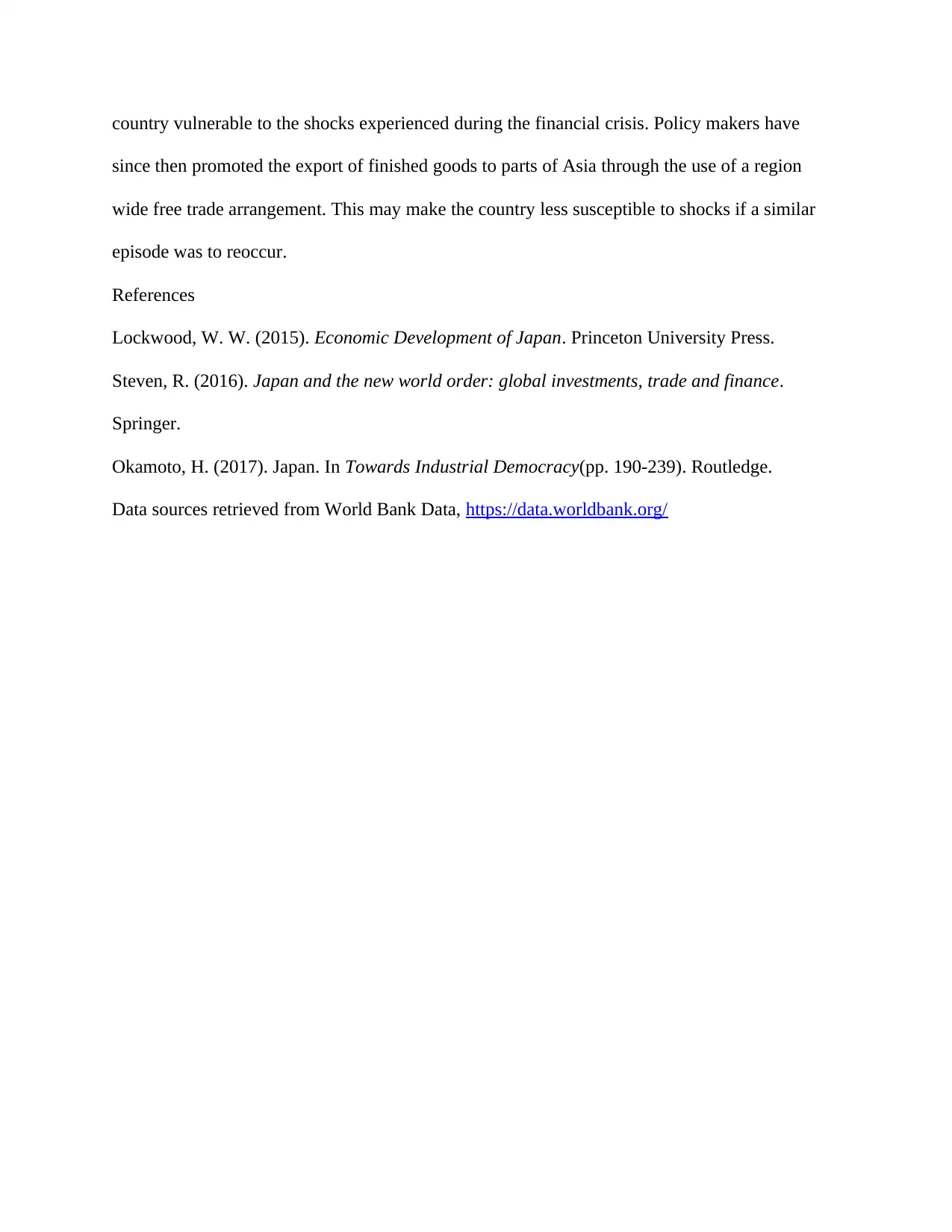
country vulnerable to the shocks experienced during the financial crisis. Policy makers have
since then promoted the export of finished goods to parts of Asia through the use of a region
wide free trade arrangement. This may make the country less susceptible to shocks if a similar
episode was to reoccur.
References
Lockwood, W. W. (2015). Economic Development of Japan. Princeton University Press.
Steven, R. (2016). Japan and the new world order: global investments, trade and finance.
Springer.
Okamoto, H. (2017). Japan. In Towards Industrial Democracy(pp. 190-239). Routledge.
Data sources retrieved from World Bank Data, https://data.worldbank.org/
since then promoted the export of finished goods to parts of Asia through the use of a region
wide free trade arrangement. This may make the country less susceptible to shocks if a similar
episode was to reoccur.
References
Lockwood, W. W. (2015). Economic Development of Japan. Princeton University Press.
Steven, R. (2016). Japan and the new world order: global investments, trade and finance.
Springer.
Okamoto, H. (2017). Japan. In Towards Industrial Democracy(pp. 190-239). Routledge.
Data sources retrieved from World Bank Data, https://data.worldbank.org/
1 out of 7
Related Documents
Your All-in-One AI-Powered Toolkit for Academic Success.
+13062052269
info@desklib.com
Available 24*7 on WhatsApp / Email
![[object Object]](/_next/static/media/star-bottom.7253800d.svg)
Unlock your academic potential
Copyright © 2020–2025 A2Z Services. All Rights Reserved. Developed and managed by ZUCOL.




